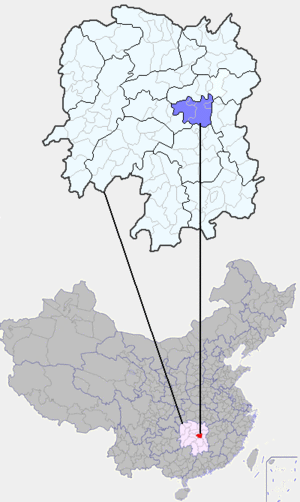Xiangtan
| Xiāngtán Shì 湘潭 市 Xiangtan |
|
|---|---|
 JinYuan Square |
|
| Coordinates | 27 ° 51 ' N , 112 ° 55' E |
 Location in Hunan Province |
|
| Basic data | |
| Country | People's Republic of China |
| region | Central China |
| province | Hunan |
| ISO 3166-2 | CN-HN |
| status | District-free city |
| structure | 2 city districts, 1 district, 2 independent cities |
| height | 802 m |
| surface | 280 km² |
| Metropolitan area | 5006 km² |
| Residents | 684,600 (2010) |
| Metropolitan area | 2,748,552 (2010) |
| density | 2445 Ew. / km² |
| Metropolitan area | 549.1 Ew. / km² |
| Post Code | 411100 |
| Telephone code | (+86) 731 |
| Time zone | China Standard Time (CST) UTC +8 |
| License Plate | 湘 C |
| Website | www.xiangtan.gov.cn |
| politics | |
| mayor | Wu Qixiu (吴奇 修) |
Xiangtan ( Chinese 湘潭 市 , Pinyin Xiāngtán Shì ) is a district-free city in the east of the Chinese province of Hunan .
It is located at the mouth of the Lian Shui涟水 River in the Xiang Jiang . It has a river port and a train station . It has a textile and steel industry and has long been an important trading point for rice . Xiangtan is also traditionally known in China for its betel nut products . Xiangtan has an area of 5,006 km² and a population of around 2.81 million (2004).
Shaoshan , the birthplace of Mao Zedong , also belongs to Xiangtan .
Administrative structure
At the county level, Xiangtan is made up of two city districts, a district and two independent cities. These are:
- Yuetang District (岳塘区), 206 km², 330,000 inhabitants, seat of the city government;
- Yuhu District (雨湖 区), 74 km², 370,000 inhabitants;
- Xiangtan County (湘潭 县), 2,513 km², 1.12 million inhabitants, capital: Yisuhe Township (易 俗 河镇);
- Xiangxiang City (湘乡 市), 2,003 km², 890,000 inhabitants;
- Shaoshan City (韶山 市), 210 km², 100,000 inhabitants.
Infrastructure
Water supply
There are currently three waterworks in Xiangtan with a capacity of around 600,000 tons / day. A fourth waterworks with a capacity of an additional 400,000 tons is currently being built.
transport
The city is connected to the railway network of the People's Republic of China with two railway lines . A number of companies are also directly connected to these.
economy
With both more traditional industry and modern manufacturing companies, Xiangtan is an important industrial city in China. In addition to companies from the secondary sector, for example from the areas of: electrical engineering, metallurgy, chemical industry and building materials industry, a number of high-tech companies have now settled in Xiangtan. This includes companies from the areas of “new materials”, biopharmaceuticals and “modern production industries”.
Town twinning
-
 Changning , People's Republic of China, since 1984
Changning , People's Republic of China, since 1984 -
 Hikone , Japan, since 1991
Hikone , Japan, since 1991 -
 South El Monte , United States, since 1994
South El Monte , United States, since 1994 -
 Haikou , People's Republic of China, since 1998
Haikou , People's Republic of China, since 1998 -
 Biên Hòa , Vietnam, since 2001
Biên Hòa , Vietnam, since 2001 -
 Lutsk , Ukraine, since 2003
Lutsk , Ukraine, since 2003 -
 León , Spain, since 2010
León , Spain, since 2010 -
 Terneuzen , Netherlands, since 2011
Terneuzen , Netherlands, since 2011 -
 Long Xuyên , Vietnam, since 2011
Long Xuyên , Vietnam, since 2011
Web links
- Official Website (Chinese)
